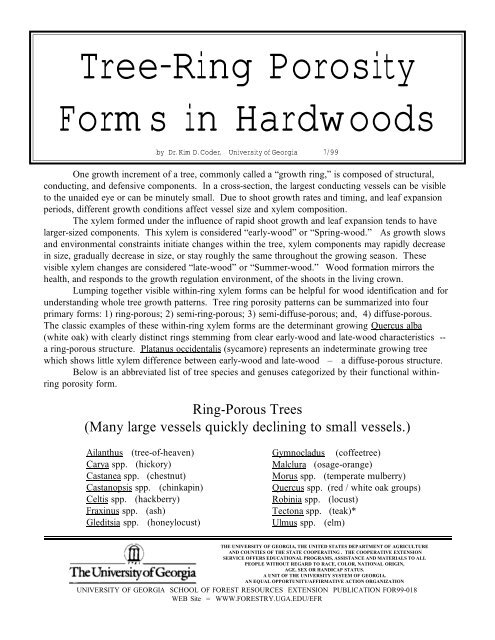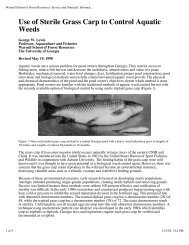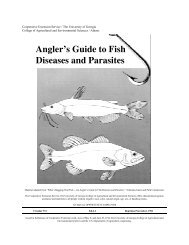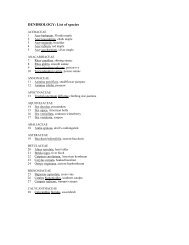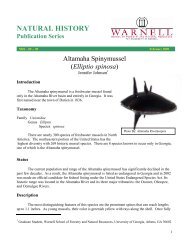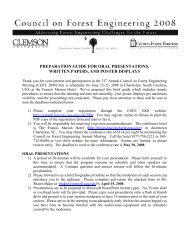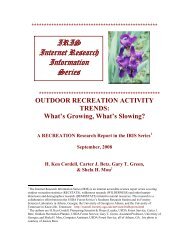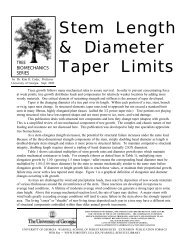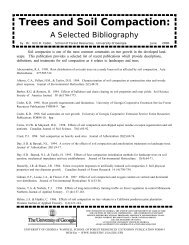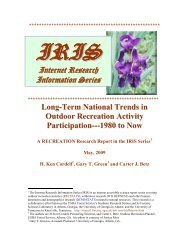Tree-Ring Porosity Forms in Hardwoods - University of Georgia
Tree-Ring Porosity Forms in Hardwoods - University of Georgia
Tree-Ring Porosity Forms in Hardwoods - University of Georgia
Create successful ePaper yourself
Turn your PDF publications into a flip-book with our unique Google optimized e-Paper software.
<strong>Tree</strong>-<strong>R<strong>in</strong>g</strong> <strong>Porosity</strong><strong>Forms</strong> <strong>in</strong> <strong>Hardwoods</strong>by Dr. Kim D. Coder, <strong>University</strong> <strong>of</strong> <strong>Georgia</strong> 7/99One growth <strong>in</strong>crement <strong>of</strong> a tree, commonly called a “growth r<strong>in</strong>g,” is composed <strong>of</strong> structural,conduct<strong>in</strong>g, and defensive components. In a cross-section, the largest conduct<strong>in</strong>g vessels can be visibleto the unaided eye or can be m<strong>in</strong>utely small. Due to shoot growth rates and tim<strong>in</strong>g, and leaf expansionperiods, different growth conditions affect vessel size and xylem composition.The xylem formed under the <strong>in</strong>fluence <strong>of</strong> rapid shoot growth and leaf expansion tends to havelarger-sized components. This xylem is considered “early-wood” or “Spr<strong>in</strong>g-wood.” As growth slowsand environmental constra<strong>in</strong>ts <strong>in</strong>itiate changes with<strong>in</strong> the tree, xylem components may rapidly decrease<strong>in</strong> size, gradually decrease <strong>in</strong> size, or stay roughly the same throughout the grow<strong>in</strong>g season. Thesevisible xylem changes are considered “late-wood” or “Summer-wood.” Wood formation mirrors thehealth, and responds to the growth regulation environment, <strong>of</strong> the shoots <strong>in</strong> the liv<strong>in</strong>g crown.Lump<strong>in</strong>g together visible with<strong>in</strong>-r<strong>in</strong>g xylem forms can be helpful for wood identification and forunderstand<strong>in</strong>g whole tree growth patterns. <strong>Tree</strong> r<strong>in</strong>g porosity patterns can be summarized <strong>in</strong>to fourprimary forms: 1) r<strong>in</strong>g-porous; 2) semi-r<strong>in</strong>g-porous; 3) semi-diffuse-porous; and, 4) diffuse-porous.The classic examples <strong>of</strong> these with<strong>in</strong>-r<strong>in</strong>g xylem forms are the determ<strong>in</strong>ant grow<strong>in</strong>g Quercus alba(white oak) with clearly dist<strong>in</strong>ct r<strong>in</strong>gs stemm<strong>in</strong>g from clear early-wood and late-wood characteristics --a r<strong>in</strong>g-porous structure. Platanus occidentalis (sycamore) represents an <strong>in</strong>determ<strong>in</strong>ate grow<strong>in</strong>g treewhich shows little xylem difference between early-wood and late-wood – a diffuse-porous structure.Below is an abbreviated list <strong>of</strong> tree species and genuses categorized by their functional with<strong>in</strong>r<strong>in</strong>gporosity form.<strong>R<strong>in</strong>g</strong>-Porous <strong>Tree</strong>s(Many large vessels quickly decl<strong>in</strong><strong>in</strong>g to small vessels.)Ailanthus (tree-<strong>of</strong>-heaven)Carya spp. (hickory)Castanea spp. (chestnut)Castanopsis spp. (ch<strong>in</strong>kap<strong>in</strong>)Celtis spp. (hackberry)Frax<strong>in</strong>us spp. (ash)Gleditsia spp. (honeylocust)Gymnocladus (c<strong>of</strong>feetree)Malclura (osage-orange)Morus spp. (temperate mulberry)Quercus spp. (red / white oak groups)Rob<strong>in</strong>ia spp. (locust)Tectona spp. (teak)*Ulmus spp. (elm)THE UNIVERSITY OF GEORGIA, THE UNITED STATES DEPARTMENT OF AGRICULTUREAND COUNTIES OF THE STATE COOPERATING . THE COOPERATIVE EXTENSIONSERVICE OFFERS EDUCATIONAL PROGRAMS, ASSISTANCE AND MATERIALS TO ALLPEOPLE WITHOUT REGARD TO RACE, COLOR, NATIONAL ORIGIN,AGE, SEX OR HANDICAP STATUS.A UNIT OF THE UNIVERSITY SYSTEM OF GEORGIA.AN EQUAL OPPORTUNITY/AFFIRMATIVE ACTION ORGANIZATIONUNIVERSITY OF GEORGIA SCHOOL OF FOREST RESOURCES EXTENSION PUBLICATION FOR99-018WEB Site = WWW.FORESTRY.UGA.EDU/EFR
Semi-<strong>R<strong>in</strong>g</strong>(Few large vessels decl<strong>in</strong><strong>in</strong>gto small vessels.)Carya spp. (hickory)Catalpa spp. (catalpa)Cladrastis (yellowwood)Diospyros (persimmon)Juglans spp. (walnut)Morus spp. (temperate mulberry)Prunus spp. (cherry)Quercus spp. (live oak group)Sassafras (sassafras)Ulmus spp. (elm)Semi-Diffuse(Many small vessels decl<strong>in</strong><strong>in</strong>gslightly to smaller vessels.)Lithocarpus (tanoak)Populus spp. (poplar / aspen / cottonwood)Quercus spp. (evergreen oak group)Salix spp. (willow)Diffuse-Porous <strong>Tree</strong>s(Many small vessels across growth <strong>in</strong>crement.)Acer spp. (hard / s<strong>of</strong>t maple)Aesculus spp. (buckeye)Afzelia spp. (l<strong>in</strong>gue)*Alnus spp. (alder)Antiaria spp. (ako)*Arbutus spp. (madrone)Aucoumea spp. (okoume’)*Betula spp. (birch)Canarium spp. (aiele’)*Carp<strong>in</strong>us spp. (hornbeam)Ceratonia spp. (carobtree)Chlorophora spp. (odoum / iroko)*Cornus spp. (dogwood)Corylus spp. (hazel)Dalbergia spp. (rosewood)*Dumoria spp. (makore’)*Entandrophragma spp.(kosipo / sapele / sipo / tiama)*Fagus spp. (beech)Gonystylus spp. (ram<strong>in</strong>)*Guibourtia spp. (amazakoue’)*Ilex spp. (holly)Khaya spp. (acajou)*Liquidambar spp. (sweetgum)Liriodendron (yellow-poplar)Lithocarpus (tanoak)Lovoa spp. (dibetou)*Magnolia spp. (magnolia)Mansonia spp. (bete’)*Microberl<strong>in</strong>ia spp. (zebrano / z<strong>in</strong>gana)*Morus spp. (tropical mulberry)*Nauclea spp. (opepe)*Nyssa spp. (gum / tupelo)Ochroma spp. (balsa)*Olea spp. (olive-tree)Ostrya spp. (hophornbeam)Oxydendrum (sourwood)Parashorea spp. (white lauan)*Platanus spp. (sycamore)Populus spp. (poplar / aspen / cottonwood)Pterocarpus spp. (padauk)*Rhamnus spp. (buckthorn)Salix spp. (willow)Shorea spp. (red lauan)*Sorbus spp. (mounta<strong>in</strong> ash)Swietenia spp. (mahogany)*Tarrietia spp. (niangon)*Term<strong>in</strong>alia spp. (afara / idigbo)*Tilia spp. (basswood / l<strong>in</strong>den)Triplochiton spp. (obeche)*Umbellularia spp. (laurel)* tropical2


